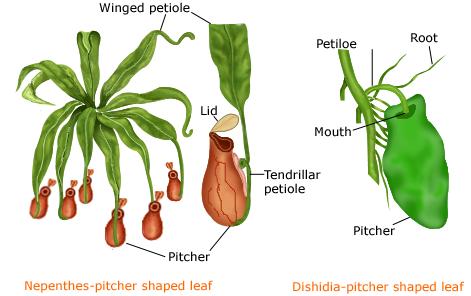[Short Notes – E&B] NCERT Class VII – Science – Nutrition in Plants – Chapter 1 – Part 2
[Short Notes – E&B] NCERT Class VII – Science – Nutrition in Plants – Chapter 1 – Part 1
\/
OTHER MODES OF NUTRITION IN PLANTS
\/
There are some plants which do not have chlorophyll. They cannot synthesise
their food.
\/
Like humans and animals such plants depend on the food produced by other
plants.
They use the heterotrophic mode of nutrition.
\/
e.g. Cuscuta (Amarbel) . It takes readymade food from the planton which it is climbing.
The plant on which it climbs is called a host. Since it deprives the host of valuable nutrients, it is called a parasite .
\/
There are a few plants which can trap insects and digest them. Such plants may be
green or of some other colour.
The pitcher-like structure is the modified part of the leaf.
The apex of the leaf forms a lid which can open and close the mouth of the pitcher.
\/
Inside the pitcher there are hair which are directed downwards.
When an insect lands in the pitcher, the lid closes and the trapped insect gets entangled into the hair.
The insect is digested by the digestive juices secreted in the pitcher.
Such insect-eating plants are called insectivorous plants.
\/
CELLS
\/
The bodies of living organisms are made of tiny units called cells.
Cells can be seen only under the microscope.
Some organisms are made of only one cell.
The cell is enclosed by a thin outer boundary, called the cell membrane.
Most cells have a distinct, centrally located spherical structure called the nucleus.
The nucleus is surrounded by a jelly-like substance called cytoplasm.
\/
\/
SAPROTROPHS
\/
Evern Noticed :
Packets of mushrooms sold in the vegetable market.
Fluffy umbrella-like patches growing on rotting wood during the rainy season.
\/
These organisms are called fungi. They have a different mode of nutrition.
\/
They secrete digestive juices on the dead and decaying matter and convert it into
a solution.
\/
Then they absorb thenutrients from it.
\/
This mode of nutrition in which organisms take in nutrients in solution form from dead and decaying
matter is called saprotrophic nutrition.
\/
Plants which use saprotrophic mode of nutrition are called saprotrophs.
\/
Many fungi like yeast and mushrooms are useful, but some fungi cause diseases in plants, animals and humans.
Some fungi are also used in medicines.
\/
How fungi appear suddenly during the rainy season ?
\/
The fungal spores are generally present in the air. When they land on wet and warm things they germinate and grow.
\/
Symbiotic Relationship
\/
Some organisms live together and share shelter and nutrients.
\/
Certain fungi live in the roots of trees. The tree provides nutrients to the fungus and, in return, receives help from it to take up water and nutrients from the soil.
This association is very important for the tree.
\/
In organisms called lichens lichens, a chlorophyll-containing partner, which is an alga, and a fungus live together.
\/
Fungus provides shelter, water and minerals to the alga and, in return, the alga provides food which it prepares by
photosynthesis.
\/
HOW NUTRIENTS ARE REPLENISHED IN THE SOIL
\/
Plants absorb mineral nutrients from the soil. So, their amounts in the soil keep on declining.
\/
Fertilisers and manures contain plant nutrients such as nitrogen, potassium,phosphorous, etc.
\/
These nutrients need to be added from time to time to enrich the soil.
\/
Usually crops require a lot of nitrogen to make proteins. After the harvest, the soil becomes deficient in nitrogen.
\/
Plants need nitrogen in a soluble form. The bacterium called Rhizobium can take atmospheric nitrogen and convert it into a soluble form.
But Rhizobium cannot make its own food. So it lives in the roots of gram, peas, moong beans and other legumes and provides them with nitrogen.
Most of the pulses (dals) are obtained from leguminous plants.
In return, the plants provide food and shelter to the bacteria.
They have a symbiotic relationship.
Farmers do not need to add nitrogen fertiliser to the soil in which leguminous plants are grown.
\/
All animals are categorised as heterotrophs.
Plants are autotrophs.
Only a few plants adopt other modes of nutrition like parasitic and saprotrophic.
\/
Share it on Facebook/Twitter/G+
\/
[Short Notes – E&B] NCERT Class VII – Science – Nutrition in Animals – Chapter 2 – Part 1














